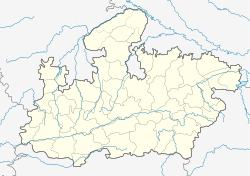Besnagar
| Vidisha | |
|---|---|
| City | |

SATI Vidisha
|
|
| Coordinates: 23°32′N 77°49′E / 23.53°N 77.82°ECoordinates: 23°32′N 77°49′E / 23.53°N 77.82°E | |
| Country | India |
| State | Madhya Pradesh |
| Languages | |
| • Official | Hindi |
Vidisha is a city in the state of Madhya Pradesh, India, located near the state capital Bhopal. Vidishā is the administrative headquarters of Bhelsa during the medieval period.
Vidisha is located at 23°32′N 77°49′E / 23.53°N 77.82°E. It has an average elevation of 424 metres (1391 feet).
As of 2011[update] India census, Vidisha had a population of 155,959. Males constitute 53.21% of the population and females 46.79%. Vidisha has an average literacy rate of 86.88%, higher than the national average of 74.04%: male literacy is 92.29%, and female literacy is 80.98%. In Vidisha, 15% of the population is under 6 years of age.
Near the eastern edge of the old town are the remains of a large temple of the late Paramara period known as the Bijamaṇḍal. The building was probably started in the second half of the 11th century. That it was never finished is shown by carved niches and unfinished architectural pieces found round the base of the temple plinth. On top of the plinth is a small mosque made using pillars, one of which has an inscription dating probably from the time of king Naravarman (circa 1094-1134). It is a devotional inscription revering Carccikā (i.e. Cāmuṇḍā), of whom he was a devotee. The miḥrāb suggests the mosque was constructed in the late 14th century. To one side of the Bijamaṇḍal is a store house of the Archaeological Survey of India containing many sculptures collected in the neighbourhood. A step-well of the 7th century is in the same campus and has, beside the entrance, two tall pillars with Kṛṣṇa scenes. These are the earliest Kṛṣṇa scenes in the art of central India.
The town is situated east of the Betwa River, in the fork of the Betwa and Bes rivers, 9 km from Sanchi. The town of Besnagar, 3 km from present-day Vidisha on the west side of the river, became an important trade centre in the 6th and 5th centuries BCE, under the Shungas, Nagas, Satavahanas, and Guptas, and was mentioned in the Pali scriptures. The Emperor Ashoka was the governor of Vidisha during his father's lifetime. His Buddhist Empress Vidisha Devi who was also his first wife was brought up in Vidisha. It finds mention in Kalidasa's Meghdoot.
...
Wikipedia


